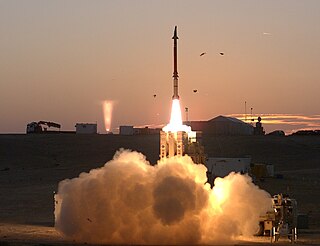
An anti-ballistic missile (ABM) is a surface-to-air missile designed to counter ballistic missiles. Ballistic missiles are used to deliver nuclear, chemical, biological, or conventional warheads in a ballistic flight trajectory. The term "anti-ballistic missile" is a generic term conveying a system designed to intercept and destroy any type of ballistic threat; however, it is commonly used for systems specifically designed to counter intercontinental ballistic missiles (ICBMs).

In military terminology, a missile is a guided airborne ranged weapon capable of self-propelled flight usually by a jet engine or rocket motor. Missiles are thus also called guided missiles or guided rockets. Missiles have five system components: targeting, guidance system, flight system, engine and warhead. Missiles come in types adapted for different purposes: surface-to-surface and air-to-surface missiles, surface-to-air missiles, air-to-air missiles, and anti-satellite weapons.

The Strategic Defense Initiative (SDI), derisively nicknamed the "Star Wars program", was a proposed missile defense system intended to protect the United States from attack by ballistic strategic nuclear weapons. The concept was announced on March 23, 1983, by President Ronald Reagan, a vocal critic of the doctrine of mutually assured destruction (MAD), which he described as a "suicide pact". Reagan called upon American scientists and engineers to develop a system that would render nuclear weapons obsolete.

The Boeing YAL-1 Airborne Laser Testbed weapons system was a megawatt-class chemical oxygen iodine laser (COIL) mounted inside a modified military Boeing 747-400F. It was primarily designed as a missile defense system to destroy tactical ballistic missiles (TBMs) while in boost phase. The aircraft was designated YAL-1A in 2004 by the U.S. Department of Defense.

The Arrow or Hetz is a family of anti-ballistic missiles designed to fulfill an Israeli requirement for a missile defense system that would be more effective against ballistic missiles than the MIM-104 Patriot surface-to-air missile. Jointly funded and produced by Israel and the United States, development of the system began in 1986 and has continued since, drawing some contested criticism. Undertaken by the MALAM division of the Israel Aerospace Industries (IAI) and Boeing, it is overseen by the Israeli Ministry of Defense's "Homa" administration and the U.S. Missile Defense Agency.
Anti-satellite weapons (ASAT) are space weapons designed to incapacitate or destroy satellites for strategic or tactical purposes. Several nations possess operational ASAT systems. Although no ASAT system has yet been utilised in warfare, a few countries have successfully shot down their own satellites to demonstrate their ASAT capabilities in a show of force. ASATs have also been used to remove decommissioned satellites.

The Aegis Ballistic Missile Defense System, also known as Sea-Based Midcourse, is a United States Department of Defense Missile Defense Agency program developed to provide missile defense against short to intermediate-range ballistic missiles. The program is part of the United States national missile defense strategy and European NATO missile defence system.

National missile defense (NMD) is a generic term for a type of missile defense intended to shield an entire country against incoming missiles, such as intercontinental ballistic missile (ICBMs) or other ballistic missiles.
Orbital Sciences Corporation was an American company specializing in the design, manufacture and launch of small- and medium- class space and launch vehicle systems for commercial, military and other government customers. In 2014, Orbital merged with Alliant Techsystems to create a new company called Orbital ATK, Inc., which in turn was purchased by Northrop Grumman in 2018. The remnants of the former Orbital Sciences Corporation today are a subsidiary of Northrop Grumman known as Northrop Grumman Space Systems.

Ground-Based Midcourse Defense (GMD) is the United States' anti-ballistic missile system for intercepting incoming warheads in space, during the midcourse phase of ballistic trajectory flight. It is a major component of the American missile defense strategy to counter ballistic missiles, including intercontinental ballistic missiles (ICBMs) carrying nuclear, chemical, biological or conventional warheads. The system is deployed in military bases in the states of Alaska and California; in 2018 comprising 44 interceptors and spanning 15 time zones with sensors on land, at sea, and in orbit. In 2019, a missile defense review requested that 20 additional ground-based interceptors be based in Alaska.

Terminal High Altitude Area Defense (THAAD), formerly Theater High Altitude Area Defense, is an American anti-ballistic missile defense system designed to shoot down short-, medium-, and intermediate-range ballistic missiles in their terminal phase by intercepting with a hit-to-kill approach. THAAD was developed after the experience of Iraq's Scud missile attacks during the Gulf War in 1991. The THAAD interceptor carries no warhead, instead relying on its kinetic energy of impact to destroy the incoming missile.

The Missile Defense Agency (MDA) is the section of the United States government's Department of Defense responsible for developing a layered defense against ballistic missiles. It had its origins in the Strategic Defense Initiative (SDI) which was established in 1983 by Ronald Reagan and which was headed by Lt. General James Alan Abrahamson. Under the Strategic Defense Initiative's Innovative Sciences and Technology Office headed by physicist and engineer Dr. James Ionson, the investment was predominantly made in basic research at national laboratories, universities, and in industry. These programs have continued to be key sources of funding for top research scientists in the fields of high-energy physics, advanced materials, supercomputing/computation, and many other critical science and engineering disciplines—funding which indirectly supports other research work by top scientists, and which was most politically viable to fund within the Military budget of the United States environment. It was renamed the Ballistic Missile Defense Organization in 1993, and then renamed the Missile Defense Agency in 2002. The current director is U.S. Navy Vice Admiral Jon A. Hill.

The ASM-135 ASAT is an air-launched anti-satellite multistage missile that was developed by Ling-Temco-Vought's LTV Aerospace division. The ASM-135 was carried exclusively by United States Air Force (USAF) F-15 Eagle fighter aircraft.

The RIM-161 Standard Missile 3 (SM-3) is a ship-based surface-to-air missile system used by the United States Navy to intercept short- and intermediate-range ballistic missiles as a part of Aegis Ballistic Missile Defense System. Although primarily designed as an anti-ballistic missile, the SM-3 has also been employed in an anti-satellite capacity against a satellite at the lower end of low Earth orbit. The SM-3 is primarily used and tested by the United States Navy and also operated by the Japan Maritime Self-Defense Force.
A number of suborbital spaceflights were conducted during 2008. These consist mostly of sounding rocket missions and missile tests, and include other flights such as an ASAT firing. Between the start of the year and 16 July, at least 43 publicly announced suborbital spaceflights were conducted, the first of them on 11 January.

The Multiple Kill Vehicle (MKV) was a planned U.S. missile defense program whose goal was to design, develop, and deploy multiple small kinetic energy-based warheads that can intercept and destroy multiple ballistic missiles, including possible decoy targets.
The Space Tracking and Surveillance System (STSS) was a pair of satellites developed by the United States Missile Defense Agency (MDA) to research the space-based detection and tracking of ballistic missiles. Data from STSS satellites could allow interceptors to engage incoming missiles earlier in flight than would be possible with other missile detection systems. The STSS program began in 2001, when the "SBIRS Low" program was transferred to MDA from the United States Air Force. In December 2002, SBIRS Low Research & Development was renamed Space Tracking and Surveillance System (STSS).

David's Sling, also formerly known as Magic Wand, is an Israel Defense Forces military system being jointly developed by the Israeli defense contractor Rafael Advanced Defense Systems and the American defense contractor Raytheon, designed to intercept enemy planes, drones, tactical ballistic missiles, medium- to long-range rockets and cruise missiles, fired at ranges from 40 km to 300 km. David's Sling is meant to replace the MIM-23 Hawk and MIM-104 Patriot in the Israeli arsenal.

The Arrow 3 or Hetz 3 is an exoatmospheric hypersonic anti-ballistic missile, jointly funded, developed and produced by Israel and the United States. Undertaken by Israel Aerospace Industries (IAI) and Boeing, it is overseen by the Israeli Ministry of Defense's "Homa" administration and the U.S. Missile Defense Agency. It provides exo-atmospheric interception of ballistic missiles, including intercontinental ballistic missiles (ICBMs) carrying nuclear, chemical, biological or conventional warheads. With divert motor capability, its kill vehicle can switch directions dramatically, allowing it to pivot to see approaching satellites. The missile may have a reported flight range of up to 2,400 km (1,500 mi).

The Ground-Based Interceptor (GBI) is the anti-ballistic missile component of the United States' Ground-Based Midcourse Defense (GMD) system.














